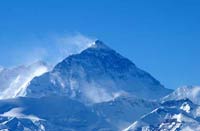New Zealand volcano eruption injures climber
Mount Ruapehu volcano in New Zealand was coated black with mud and ash Wednesday after a sudden eruption sent mud and rocks down its slopes and seriously injured a climber, officials said.

The volcano erupted Tuesday evening, and airplane pilots reported seeing a cloud of ash and steam about 4 kilometers (15,000 feet) above its peak.
"The top of the mountain is black, covered in crater lake mud and ash ... that goes out about a kilometer (a half-mile) from the summit," vulcanologist Brad Scott said.
Climber William Pike, 22, suffered serious injuries when a large rock crashed through a mountain shelter and crushed his legs, rescue officials said.
Rescuer Andy Hoyle said the boulder came "through the front door ... and it took quite an effort to get the material off his legs." Pike was flown by helicopter to nearby Waikato Hospital where he remained in intensive care Wednesday.
One mud flow temporarily trapped a snow groomer at a ski area, and two other workers there suffered minor injuries, Ruapehu district council spokesman Paul Wheatcroft said.
About 60 skiers at two ski lodges were evacuated from the mountain before the short, sharp eruption was declared over.
Roads and rail tracks near the mountain were closed by police, but later reopened.
Mt. Ruapehu in central North Island has erupted five times since 1969, with one in 1995 causing widespread damage when it tossed huge quantities of ash and rocks - the size of large cars - from its crater.
A mud flow from the crater lake caused New Zealand's worst train accident on Christmas Eve 1953, in which 151 were killed as millions of liters (gallons) of mud and water crashed down the mountain's slopes.
After an inspection flight over the mountain Wednesday, Scott said the eruption was "small to moderate" - level 2 on a scale of 1 to 5 - and had sparked a seven-minute earthquake of magnitude 2.8.
The explosion tossed rocks up to one and a half kilometers (0.9 of a mile) from the crater, leaving "impact craters" up to two meters (yards) wide in the snow, he said.
Two mud flows from the crater "were not significant at all," with only one reaching the base of the mountain, he added.
The eruption was caused by a buildup of steam under the crater lake rather than driven by "new lava flowing into the volcano," Scott said
Tuesday night's eruption was similar to those in 1969 and 1975 but smaller than one 12 years ago that caused widespread damage, vulcanologist Craig Miller said.
Miller said the eruption had occurred without any warning.
"Looking at our seismic instruments it was ... from nothing to full (eruption) in the space of a minute," he said, adding that such occurrences are "reasonably rare."
Subscribe to Pravda.Ru Telegram channel, Facebook, RSS!





